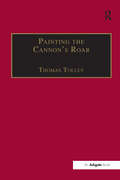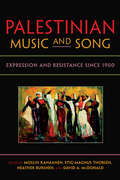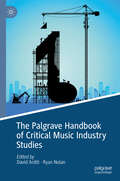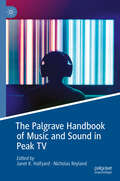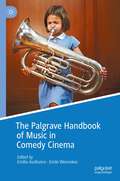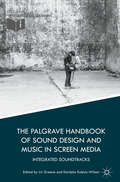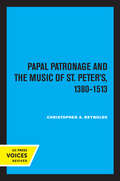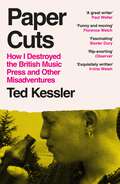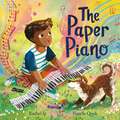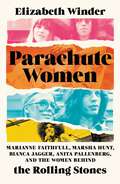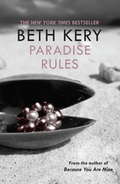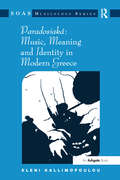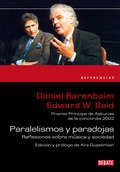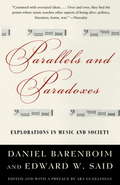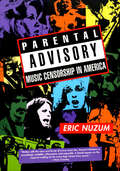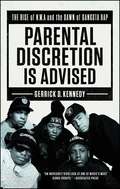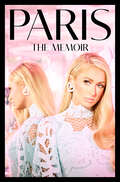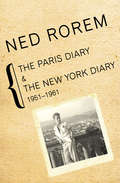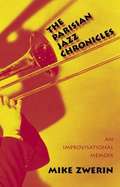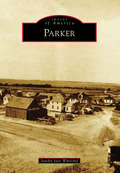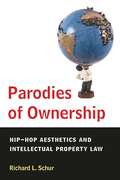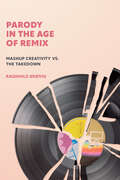- Table View
- List View
Painting the Cannon's Roar: Music, the Visual Arts and the Rise of an Attentive Public in the Age of Haydn
by Thomas TolleyFrom c.1750 to c.1810 the paths of music history and the history of painting converged with lasting consequences. The publication of Newton's Opticks at the start of the eighteenth century gave a 'scientific' basis to the analogy between sight and sound, allowing music and the visual arts to be defined more closely in relation to one another. This was also a period which witnessed the emergence of a larger and increasingly receptive audience for both music and the visual arts - an audience which potentially included all social strata. The development of this growing public and the commercial potential that it signified meant that for the first time it became possible for a contemporary artist to enjoy an international reputation. Nowhere is this better illustrated than in the career of Joseph Haydn. Although this phenomenon defies conventional modes of study, the book shows how musical pictorialism became a major creative force in popular culture. Haydn, the most popular living cultural personality of the period, proved to be the key figure in advancing the new relationship. The connections between the composer and his audiences and leading contemporary artists (including Tiepolo, Mengs, Kauffman, Goya, David, Messerschmidt, Loutherbourg, Canova, Copley, Fuseli, Reynolds, Gillray and West) are examined here for the first time. By the early nineteenth century, populism was beginning to be regarded with scepticism and disdain. Mozart was the modern Raphael, Beethoven the modern Michelangelo. Haydn, however, had no clear parallel in the accepted canon of Renaissance art. Yet his recognition that ordinary people had a desire to experience simultaneous aural and visual stimulation was not altogether lost, finding future exponents in Wagner and later still in the cinematic arts.
Palestinian Music and Song: Expression And Resistance Since 1900 (Public Cultures Of The Middle East And North Africa Ser.)
by David A. Mcdonald Stig-Magnus Thorsén Heather Bursheh Moslih KanaanehDrawing from a long history of indigenous traditions and incorporating diverse influences of surrounding cultures, music in Palestine and among the millions of Palestinians in diaspora offers a unique window on cultural and political events of the past century. From the perspective of scholars, performers, composers, and activists, Palestinian Music and Song examines the many ways in which music has been a force of representation, nation building, and social action. From the turn of the 20th century, when Palestine became an exotic object of fascination for missionaries and scholars, to 21st-century transnational collaborations in hip hop and new media, this volume traces the conflicting dynamics of history and tradition, innovation and change, power and resistance.
The Palgrave Handbook of Critical Music Industry Studies
by David Arditi Ryan NolanThe Handbook of Critical Music Industry Studies provides students and researchers with the means to think about how the performance, recording, and publishing of music could be if we do things differently. People are hungry for a more equitable music performance and recording system. The industry exudes patriarchy, white supremacy, cultural imperialism, ableism, and worker exploitation. In the context of gendered (e.g., #MeToo and #TimesUp) and racialized (e.g., Black Lives Matter) inequity, rampant precarity and casualization, and modes of musical dissemination that are changing faster than policymakers and regulatory bodies can keep up with, the timing for assembling such an interdisciplinary collection could not be more appropriate. Essays in this handbook will tackle power structures at root in the music industry and the academic study of the field. Topics covered include the politics of representation and power in the global music industries, the labor of music, music as media (including data and algorithmic culture), and copyright/intellectual property, among others.
The Palgrave Handbook of Music and Sound in Peak TV
by Janet K. Halfyard Nicholas ReylandThe Palgrave Handbook to Music and Sound in Peak TV charts the transformation of television’s sonic storytelling during the new “golden age” of televisual narrative from the late 1990s to the early 2020s. Grounded in close analytical, critical, and theoretical work identifying the key traits of music and sound in this “peak TV” period, the book casts its critical net wider to develop interpretations of significance not just for screen music studies and musicology, but for screen and media studies too. By theorizing “peakness” with respect to sound and music, and by drawing together contributions from a diverse collection of prominent musicologists, media scholars, and practitioners, this handbook provides the authoritative guide to the role music has played in creating the success of some of the most culturally and commercially significant popular art of the early twenty-first century. The volume contains 25 essays in three main sections—Concepts and Aesthetics, Practices and Production, and Audiences and Interpretations. Topics discussed include peakness, complexity, ostentatious scoring, antiheroes, memory, franchises, worldbuilding, nostalgia, maternity, trauma, actor’s voices, title sequences, library music, branding, queer/camp scoring, kids TV, captioning, industry practices, HBO, and sound design. Shows examined include The Sopranos, The Wire, Game of Thrones, Battlestar Galactica, Westworld, Buffy the Vampire Slayer, Stranger Things, The Bridge, Dexter, Killing Eve, Mad Men, American Horror Story, Rings of Power, Fargo, Peaky Blinders, Call the Midwife, Twin Peaks, and Twin Peaks: The Return.
The Palgrave Handbook of Music in Comedy Cinema
by Emilio Audissino Emile WennekesThis handbook tackles the understudied relationship between music and comedy cinema by analysing the nature, perception, and function of music from fresh perspectives. Its approach is not only multidisciplinary, but also interdisciplinary in its close examination of how music and other cinematic devices interact in the creation of comedy. The volume addresses gender representation, national identities, stylistic strategies, and employs inputs from cultural studies, musicology, music theory, psychology, cognitivism, semiotics, formal and stylistic film analysis, and psychoanalysis. It is organised in four sections: general introductions, theoretical investigations, music and comedy within national cinemas, and exemplary case studies of films or authors.
The Palgrave Handbook of Sound Design and Music in Screen Media
by Liz Greene Danijela Kulezic-WilsonThis book bridges the existing gap between film sound and film music studies by bringing together scholars from both disciplines who challenge the constraints of their subject areas by thinking about integrated approaches to the soundtrack. As the boundaries between scoring and sound design in contemporary cinema have become increasingly blurred, both film music and film sound studies have responded by expanding their range of topics and the scope of their analysis beyond those traditionally addressed. The running theme of the book is the disintegration of boundaries, which permeates discussions about industry, labour, technology, aesthetics and audiovisual spectatorship. The collaborative nature of screen media is addressed not only in scholarly chapters but also through interviews with key practitioners that include sound recordists, sound designers, composers, orchestrators and music supervisors who honed their skills on films, TV programmes, video games, commercials and music videos.
Papal Patronage and the Music of St. Peter's, 1380–1513
by Christopher Alan ReynoldsA new picture of music at the basilica of St. Peter's in the fifteenth century emerges in Christopher A. Reynolds's fascinating chronicle of this rich period of Italian musical history. Reynolds examines archival documents, musical styles, and issues of artistic patronage and cultural context in a fertile consideration of the ways historical and musical currents affected each other. This work is both a historical account of performers and composers and an examination of how their music revealed their cultural values and educational backgrounds. Reynolds analyzes several anonymous masses copied at St. Peter's, proposing attributions that have biographical implications for the composers. Taken together, the archival records and the music sung at St. Peter's reveal a much clearer picture of musical life at the basilica than either source would alone. The contents of the St. Peter's choirbook help document musical life as surely as that musical life—insofar as it can be reconstructed from the archives—illumines the choirbook. This title is part of UC Press's Voices Revived program, which commemorates University of California Press’s mission to seek out and cultivate the brightest minds and give them voice, reach, and impact. Drawing on a backlist dating to 1893, Voices Revived makes high-quality, peer-reviewed scholarship accessible once again using print-on-demand technology. This title was originally published in 1995.
Paper Cuts: How I Destroyed the British Music Press and Other Misadventures
by Ted Kessler'A great writer' Paul Weller'A music journalist of integrity' Billy Childish'There's only one Ted Kessler!' Liam GallagherPAPER CUTS is the inside story of the slow death of the British music press. But it's also a love letter to it, the tale of how music magazines saved one man's life. Ted Kessler left home and school around his seventeenth birthday, determined 'to be someone who listened to music professionally'. That dream appeared forlorn when he was later arrested for theft behind the counter of the record shop he managed during acid house's long hot summer of love. Paper Cuts tells how Kessler found redemption through music and writing and takes us on a journey alongside the stars he interviewed and the work-place dramas he navigated as a senior staffer at NME through the boom-time '90s and on to the monthly Q in 2004, where he worked for sixteen years before it folded with him at its helm as editor in 2020.We travel in time alongside musical heroes Paul Weller, Kevin Rowland, Mark E Smith, and to Cuba twice, first with Shaun Ryder and Bez, then with Manic Street Preachers. We spend long, mad nights out with Oasis and The Strokes, quality time with Jeff Buckley and Florence Welch, and watch Radiohead deliver cold revenge upon Kessler in public. A story about love and death, about what it's like when a music writer shacks up with a conflict of interest, and what happens when your younger brother starts appearing on the cover of the magazines you work for, this is the memoir of "a delinquent doofus" whose life was both rescued and defined by music magazines.
Paper Cuts: How I Destroyed the British Music Press and Other Misadventures
by Ted Kessler'A great writer' Paul Weller'A music journalist of integrity' Billy Childish'There's only one Ted Kessler!' Liam GallagherPAPER CUTS is the inside story of the slow death of the British music press. But it's also a love letter to it, the tale of how music magazines saved one man's life. Ted Kessler left home and school around his seventeenth birthday, determined 'to be someone who listened to music professionally'. That dream appeared forlorn when he was later arrested for theft behind the counter of the record shop he managed during acid house's long hot summer of love. Paper Cuts tells how Kessler found redemption through music and writing and takes us on a journey alongside the stars he interviewed and the work-place dramas he navigated as a senior staffer at NME through the boom-time '90s and on to the monthly Q in 2004, where he worked for sixteen years before it folded with him at its helm as editor in 2020.We travel in time alongside musical heroes Paul Weller, Kevin Rowland, Mark E Smith, and to Cuba twice, first with Shaun Ryder and Bez, then with Manic Street Preachers. We spend long, mad nights out with Oasis and The Strokes, quality time with Jeff Buckley and Florence Welch, and watch Radiohead deliver cold revenge upon Kessler in public. A story about love and death, about what it's like when a music writer shacks up with a conflict of interest, and what happens when your younger brother starts appearing on the cover of the magazines you work for, this is the memoir of "a delinquent doofus" whose life was both rescued and defined by music magazines.
The Paper Piano: An inspirational picture book for music lovers
by Rachel IpWhen Noah hears beautiful piano music sweeping through the station, he longs to play. Without a pianoof his own, he carefully crafts one out of paper, and the notes fill his head night and day. Until finally, with the help of a neighbour, his musical dream comes true . . .An inspirational picture book about the power of perseverance and music, celebrating the joy that railway station pianos can bring to all. Written by award-winning author Rachel Ip, with artwork from award-winning illustrator Natelle Quek.
Parachute Women: Marianne Faithfull, Marsha Hunt, Bianca Jagger, Anita Pallenberg, and the Women Behind the Rolling Stones
by Elizabeth WinderDiscover the true story of the four women who worked tirelessly behind the scenes to help shape and curate the image of The Rolling Stones—perfect for fans of Girls Like Us. The Rolling Stones have long been considered one of the greatest rock-and-roll bands of all time. At the forefront of the British Invasion and heading up the counterculture movement of the 1960s, the Stones' innovative music and iconic performances defined a generation, and fifty years later, they're still performing to sold-out stadiums around the globe. Yet, as the saying goes, behind every great man is a greater woman, and behind these larger-than-life rockstars were four incredible women whose stories have yet to be fully unpacked . . . until now.In Parachute Women, Elizabeth Winder introduces us to the four women who inspired, styled, wrote for, remixed, and ultimately helped create the legend of the Rolling Stones. Marianne Faithfull, Marsha Hunt, Bianca Jagger, and Anita Pallenberg put the glimmer in the Glimmer Twins and taught a group of straight-laced boys to be bad. They opened the doors to subterranean art and alternative lifestyles, turned them on to Russian literature, occult practices, and LSD. They connected them to cutting edge directors and writers, won them roles in art house films that renewed their appeal. They often acted as unpaid stylists, providing provocative looks from their personal wardrobes. They remixed tracks for chart-topping albums, and sometimes even wrote the actual songs. More hip to the times than the rockers themselves, they consciously (and unconsciously) kept the band current—and confident—with that mythic lasting power they still have today.Lush in detail and insight, and long overdue, Parachute Women is a group portrait of the four audacious women who transformed the Stones into international stars, but who were themselves marginalized by the male-dominated rock world of the late '60s and early '70s. Written in the tradition of Sheila Weller's Girls Like Us, it's a story of lust and rivalries, friendships and betrayals, hope and degradation, and the birth of rock and roll.
Paradise Rules
by Beth KeryFor fans for Sylvia Day, J. Kenner and Maya Banks. A sizzlingly sexy novel from the New York Times ebook bestselling author of the Because You Are Mine series and The Affair.To most people Hawaii's crystal shores are an inviting opportunity to escape reality. But for Lana Rodriguez, the picture-perfect getaway disguises the bitter truths she escaped years ago. Now a successful blues singer, Lana's returning to Waikiki with a different outlook on the past, and a bold defiance when it comes to men, romance, and sex. Local celebrity, businessman and island god, Jason Koa, may be every woman's dream. For Lana, it's not exactly love at first sight. Though their start is rocky, they can't deny the passions they arouse in each other. Jason refuses to become Lana's pawn. It's time to show her who makes the rules on this island - and in the bedroom. But will Jason's attempt at breaking Lana's shell reveal secrets that neither are prepared to face, or will they allow themselves to get swept away by a tidal wave of desire?Enter the seductive world of Beth Kery where the rules are broken with that first electrifying touch in the sizzling Because You Are Mine, One Night of Passion and The Affair novels.
Paradosiaká: Music, Meaning and Identity in Modern Greece (SOAS Studies in Music)
by Eleni KallimopoulouSince the 1980s, musicians and audiences in Athens have been rediscovering musical traditions associated with the Ottoman period of Greek history. The result of this revivalist movement has been the urban musical style of 'paradosiaká' ('traditional'). Drawing from a varied repertoire that includes Turkish art music and folk and popular musics of Greece and Turkey, and identified by the use of instruments which previously had little or no performing tradition in Greece, paradosiaká has had to define itself by negotiating contrastive tendencies towards differentiation and a certain degree of overlapping in relation to a range of indigenous Greek musics. This monograph explores paradosiaká as a musical style and as a field of discourse, seeking to understand the relation between sound and meanings constructed through sound. It draws on interviews, commercial recordings, written musical discourse, and the author's own experience as a practising paradosiaká musician. Some main themes discussed in the book are the migration of instruments from Turkey to Greece; the process of 'indigenization' whereby paradosiaká was imbued with local meanings and aesthetic value; the accommodation of the style within official and popular discourses of 'Greekness'; its prophetic role in the rapprochement of Greek culture with modern Turkey and with suppressed aspects of the Greek Ottoman legacy; as well as the varied worldviews and current musical dilemmas of individual practitioners in the context of professionalization, commercialization, and the intensification of cross-cultural contact. The text is richly illustrated with transcriptions, illustrations and includes downloadable resources. The book makes a valuable contribution to ethnomusicology, cultural studies, as well as to the study of the Balkans and the Mediterranean.
Paralelismos y paradojas
by Daniel Barenboim Edward W. SaidEl israelí Daniel Barenboim -director de la orquesta Sinfónica de Chicago y de la Ópera Estatal de Berlín- y el palestino-noreteamericano Edward Said -eminente crítico literario y comprometido analista del conflicto de Oriente Próximo- han cultivado desde hace muchos años una profunda amistad que se hace patente en el apasionado y cordial intercambio de ideas que tiene lugar en estas conversaciones.Barenboim y Said hablan, entre otras cuestiones, de las diferencias entre la escritura de prosa y la de la música, de políticos que tratan de llegar a acuerdos y de artistas que sólo se comprometen con su arte, del famoso director Furtwängler, de Beethoven como supremo compositor de sonatas, de Wagner, de maestros y discípulos y, sobre todo, del poder de la cultura para ir más allá de las barreras nacionales y las diferencias políticas.Paralelismos y paradojas es un libro de ideas originales y sorprendentes sobre música, política y cultura que despliega un derroche de inteligencia de dos grandes mitos de nuestra cultura contemporánea.
Parallels and Paradoxes: Explorations in Music and Society
by Daniel Barenboim Edward W. SaidThese free-wheeling, often exhilarating dialogues--which grew out of the acclaimed Carnegie Hall Talks--are an exchange between two of the most prominent figures in contemporary culture: Daniel Barenboim, internationally renowned conductor and pianist, and Edward W. Said, eminent literary critic and impassioned commentator on the Middle East. Barenboim is an Argentinian-Israeli and Said a Palestinian-American; they are also close friends. As they range across music, literature, and society, they open up many fields of inquiry: the importance of a sense of place; music as a defiance of silence; the legacies of artists from Mozart and Beethoven to Dickens and Adorno; Wagner's anti-Semitism; and the need for "artistic solutions" to the predicament of the Middle East--something they both witnessed when they brought young Arab and Israeli musicians together. Erudite, intimate, thoughtful and spontaneous, Parallels and Paradoxes is a virtuosic collaboration.
Parental Advisory: Music Censorship in America
by Eric D. NuzumEverything You Ever Wanted To Know About The Music Your Parents Never Wanted You To HearBelieve it or not, music censorship in America did not begin with Tipper Gore's horrified reaction to her daughter's Prince album. The vilification of popular music by government and individuals has been going on for decades. Now, for the first time, Parental Advisory offers a thorough and complete chronicle of the music that has been challenged or suppressed -- by the people or the government -- in the United States.From Dean Martin's "Wham, Bam, Thank you Ma'am" to Marilyn Manson's Antichrist Superstar; from freedom fighters such as Frank Zappa and in-your-face rappers such a N.W.A. to crusaders such as Tipper Gore, this intelligent and entertaining book shows how censorship has crossed sexual, class, and ethnic lines, and how many see it as a de facto form of racism. With nearly one hundred fascinating photographs of musicians, record burning, and controversial cover art; illuminating sidebars; and a decade-by-decade timeline of important moments in censorship history, Parental Advisory is by turns frightening and hilarious -- but always revealing.
Parental Discretion Is Advised: The Rise of N.W.A and the Dawn of Gangsta Rap
by Gerrick D. KennedyExperience the stunning rise, fall, and legacy of N.W.A. and how they put their stamp on pop culture, black culture, and hip-hop music forever in this &“incredibly vivid look at one of music&’s most iconic groups&” (Associated Press).In 1986, a group was formed that would establish the foundation of gangsta rap and push the genre forward, electrifying fans with their visceral and profane lyrics that glorified the dark ways of street life and brazenly challenged the police system. Eazy-E, Dr. Dre, Ice Cube, MC Ren, and DJ Yella caused a seismic shift in hip-hop when they decided to form N.W.A in 1986. With their hard-core image, bombastic sound, and lyrics that were equal parts poetic, lascivious, conscious, and downright in-your-face, N.W.A spoke the truth about life on the streets of Compton, California—then a hotbed of poverty, drugs, gangs, and unemployment. Going beyond the story portrayed in the 2015 blockbuster movie Straight Outta Compton, through firsthand interviews, extensive research, and top-notch storytelling, Los Angeles Times music reporter Gerrick Kennedy transports you back in time and offers a front-row seat to N.W.A&’s early days and the drama and controversy that followed the incendiary group as they rose to become multiplatinum artists. Kennedy leaves nothing off the table in his pursuit of the full story behind the group&’s most pivotal moments, such as Ice Cube&’s decision to go solo after their debut studio album became a smash hit; their battle with the FBI over inflammatory lyrics; incidents of physical assault; Dr. Dre&’s departure from the group to form Death Row Records with Suge Knight; their impact on the 1992 L.A. riots; Eazy-E&’s battle with AIDS; and much more. A bold, riveting, &“non-stop, can&’t-put-it-down ride&” (Library Journal), Parental Discretion Is Advised unveils the true and astonishing history of one of the most transcendent and controversial musical groups of the 1980s and 1990s.
Parents' and Teachers' Guide to Music Education
by Roberta MarkelPractical advice on choosing, selecting and buying an instrument, finding a good teacher, learning the language of music, singing, practicing, and careers in music
Paris: The Memoir
by Paris Hilton***An Instant New York Times Bestseller***From the woman who is credited for launching what we know as the celebrity focused, “brand” driven, social media obsessed popular culture of today, comes an honest and surprising memoir that reckons with that truth, and shows that there is so much more to Paris Hilton than you might believe.I was born in New York City on February 17, 1981, three days after Valentine’s Day. From the time I was a toddler, my brain skipped and flickered with the chemical imbalance of ADHD. Sometimes it was too much.I’m not bragging or complaining about it, just telling you: This is my brain. It has a lot to do with how this whole book thing is going to play out, because I love run-on sentences—and dashes. And sentence fragments. I’m probably going to jump around a lot while I tell the story.I came of age during the most turbulent pop culture period ever.The character I played—part Lucy, part Marilyn—was my steel-plated armor.People loved her. Or they loved to hate her, which was just as marketable. I leaned into that character, my ticket to financial freedom and a safe place to hide. I made sure I never had a quiet moment to figure out who I was without her. I was afraid of that moment because I didn’t know what I’d find.I wrote this book in an effort to understand my place in a watershed moment: the technology renaissance, the age of influencers. I also wrote this book so that the world could know who I am today. I focused on key aspects of my life that led to what I am most proud of--how my power was taken away from me and how I took it back, how I built a thriving business, a marriage and a family.There are so many young women who need to hear this story. I don’t want them to learn from my mistakes; I want them to stop hating themselves for their own mistakes. I want them to laugh and cry and embrace every aspect of who they are with fearlessness and pride. We all have our own brand of intelligence, and, girl, fuck fitting in.
The Paris Diary & The New York Diary, 1951–1961: 1951-1961
by Ned RoremIn the earliest published diaries of Ned Rorem, the acclaimed American composer recalls a bygone era and its luminaries, celebrates the creative process, and examines the gay culture of Europe and the US during the 1950sOne of America&’s most significant contemporary composers, Ned Rorem is also widely acclaimed as a diarist of unique insight and refreshing candor. Together, his Paris Diary, first published in 1966, and The New York Diary,which followed a year later, paint a colorful landscape of Rorem&’s world and its famous inhabitants, as well as a fascinating self-portrait of a footloose young artist unabashedly drinking deeply of life. In this amalgam of forthright personal reflections and cogent social commentary, unprecedented for its time, Rorem&’s anecdotal recollections of the decade from 1951 to 1961 represent Gay Liberation in its infancy as the author freely expresses his open sexuality not as a revelation but as a simple fact of life. At once blisteringly honest and exquisitely entertaining, Rorem&’s diaries expound brilliantly on the creative process, following their peripatetic author from Paris to Morocco to Italy and back home to America as he crosses paths with Picasso, Cocteau, Gide, Boulez, and other luminaries of the era. With consummate skill and unexpurgated insight, a younger, wilder Rorem reflects on a bygone time and culture and, in doing so, holds a revealing mirror to himself.
Paris Symphonies Nos. 82-87 in Full Score
by Joseph HaydnCommissioned in 1786 by the Paris-based orchestra Le Concert de la Loge Olympique, these six symphonies were created for an extraordinarily large ensemble of both professional and amateur players, including reinforced woodwind parts and a large string section. The symphonies are:Symphony No. 82 in C major, L´Ours (The Bear), 1786Symphony No. 83 in G minor, La Poule (The Hen), 1785Symphony No. 84 in E flat major, In Nomine Domini, 1786Symphony No. 85 in B flat major, La Reine (The Queen), 1785Symphony No. 86 in D major, 1786Symphony No. 87 in A major, 1785Composer Giuseppe Maria Cambini, a member of the orchestra, noted that the enthusiastically received premieres featured some of the city's finest musicians. A contemporary critic remarked that "Each hearing increases our appreciation and admiration of the works of the great genius, who, in all his pieces, understands so well how to draw the richest and most varied developments from every theme." Reproduced from the authoritative Breitkopf & Härtel editions, this volume offers musicians and music lovers an inexpensive and authoritative compilation of Haydn's ever-popular works.
The Parisian Jazz Chronicles: An Improvisational Memoir
by Mike ZwerinThis book is built around a structure that treats such subjects of my music column in the International Herald Tribune as Dexter Gordon, Freddy Heineken, Miles Davis, Bob Dylan, Chet Baker, and Melvin Van Peebles as though they were the written notes in big band arrangements.
Parker
by Sandra Jane WhelchelThe town of Parker underwent several name changes before adopting its current title. First called Pine Grove for its setting in a copse of ponderosa pines at the northern edge of Colorado's Black Forest, that name lasted through the final days of stagecoach travel. When the US Post Office officially began operations in the 1880s, officials requested that Pine Grove be renamed, as another town with that name existed on the Platte River, causing the mail to be mixed up. James Sample Parker requested that the town's name be changed to Edithville, in honor of his young daughter. Again, the US Post Office denied the request, renaming the town Parker to recognize James Sample Parker and his brother, George. From these early beginnings, Parker faced spurts of growth and recession, more recently becoming a significant Denver suburb.
Parodies of Ownership: Hip-Hop Aesthetics and Intellectual Property Law
by Richard L. SchurWhat is the relationship between hip-hop and African American culture in the post--Civil Rights era? Does hip-hop share a criticism of American culture or stand as an isolated and unique phenomenon? How have African American texts responded to the increasing role intellectual property law plays in regulating images, sounds, words, and logos? Parodies of Ownership examines how contemporary African American writers, artists, and musicians have developed an artistic form that Schur terms "hip-hop aesthetics." This book offers an in-depth examination of a wide range of contemporary African American painters and writers, including Anna Deavere Smith, Toni Morrison, Adrian Piper, Colson Whitehead, Michael Ray Charles, Alice Randall, and Fred Wilson. Their absence from conversations about African American culture has caused a misunderstanding about the nature of contemporary cultural issues and resulted in neglect of their innovative responses to the post--Civil Rights era. By considering their work as a cross-disciplinary and specifically African American cultural movement, Schur shows how a new paradigm for artistic creation has developed. Parodies of Ownership offers a broad analysis of post--Civil Rights era culture and provides the necessary context for understanding contemporary debates within American studies, African American studies, intellectual property law, African American literature, art history, and hip-hop studies. Weaving together law, literature, art, and music, Schur deftly clarifies the conceptual issues that unify contemporary African American culture, empowering this generation of artists, writers, and musicians to criticize how racism continues to affect our country.
Parody in the Age of Remix: Mashup Creativity vs. the Takedown
by Ragnhild BrøvigThe art of mashup music, its roots in parody, and its social and legal implications.Parody needn&’t recognize copyright—but does an algorithm recognize parody? The ever-increasing popularity of remix culture and mashup music, where parody is invariably at play, presents a conundrum for internet platforms, with their extensive automatic, algorithmic policing of content. Taking a wide-ranging look at mashup music—the creative and technical considerations that go into making it; the experience of play, humor, enlightenment, and beauty it affords; and the social and legal issues it presents—Parody in the Age of Remix offers a pointed critique of how society balances the act of regulating art with the act of preserving it.In several jurisdictions, national and international, parody is exempted from copyright laws. Ragnhild Brøvig contends that mashups should be understood as a form of parody, and thus be protected from removal from hosting platforms. Nonetheless, current copyright-related content-moderation regimes, relying on algorithmic detection and automated decision making, frequently eliminate what might otherwise be deemed gray-area content—to the detriment of human listeners and, especially, artists. Given the inaccuracy of takedowns, Parody in the Age of Remix makes a persuasive argument in favor of greater protection for remix creativity in the future—but it also suggests that the content-moderation challenges facing mashup producers and other remixers are symptomatic of larger societal issues.
